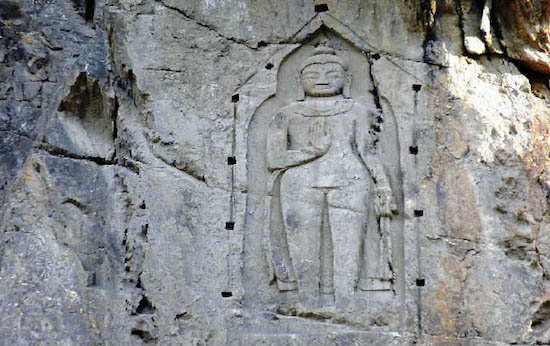`Kargha Buddha’ – one of the most potential archeological sites in Gilgit Baltistan yet to be explored – was at the risk of getting ruined due to neglect by the authorities concerned.
The province having rich historical and cultural background and ancient sites lack archeological experts to preserve the priceless heritage for the tourists and education of the upcoming generations.
`Kargha Buddha’ is a carved rock statue located near Kargha Nallah, a ravine and is 10 kilometers from Gilgit Town and is one of the most admired and short-outing place, surrounded by lush green picturesque views.
The site, after devolution under 18th Amendment of the Constitution, comes under the jurisdiction of the provincial authorities who have not started any excavation work on the site due to lack of expertise and focus, Deputy Director, Department of Archeology and Museums (DOAM) Islamabad, Abdul Ghafoor said.
Talking to APP, he said the site, if excavated and preserved, can reveal many historical facts, antiquities and help educate the future generations about the country’s heritage along with boosting the tourist activities in the region.
Muhammad Hassan who has served as Assistant Director, DOAM, Gilgit Baltistan during the years 2001-2006 said Kargha Buddha is a Buddha sculpture in Tibetan style of 4th or 5th Century A.D. The length of the statue is 40 to 50 feet while its width is yet to be estimated.
He said the rock stupas usually sustain the climatic changes of intense nature, however, the sites where these rock statues exist are needed to be excavated for finding antiquities and then preserved.
Although no excavation took place ever in this archeological site so far however during this time period, the experts discovered remains including a rare manuscript representing the Buddhist civilization from the surroundings of the site.
Muhammad Hassan, who is now Curator at Harrapa Museum, Punjab, said that the historical facts revealed that the Buddhist caravans mostly religious ones used to stay at the monastery here while going from Silk Road, which also is considered to be part of the monuments, toward China for trade purposes since centuries.
The Buddhist also used to perform their religious rituals at this site and worship the idol-like statue, he added.
Muhammad Hassan said there were more than 30,000 similar rock carvings in Gilgit Baltistan which can become a great source of attraction for the tourists, if preserved and maintained.
He said `Hunzal Stupa’ is also another archeological site in Gilgit Baltistan which is needed to be explored and preserved to boost tourism in the region.
Director Taxila Institute of Asian Civilization (TIAC) and a renowned archeological expert, Dr. Ashraf Khan said on the top of the Kargha Buddha statue from where a rare manuscript was found, there was a site named as Dinyor.
Dr. Ashraf said this site, after facing extreme weather conditions, is still rich and need urgent excavation by the archeological experts.
Those who visited the site are of the view that how the carving back in 4th or 5th Century AD was done at such a high altitude. The peak where the carving is done so straight as apparently reach on top to carry out carving is not humanly possible without the help of machinery and equipment even in this modern age.
Sajid, a local habitant of the Kargha village, told this scribe that thousands of the tourists visit Kargha Buddha site throughout the year and they consider their visit to Gilgit Baltistan incomplete without having glimpse of this unique rock sculpture.
He said it is believed that 800 years before Islam, a number of Buddhists used to come here and worship the Buddha statue.
However, according to some other myths, an evil spirit was caught in this Buddhist carved rock sculpture by some religious person save the local people from its wrath.
The evil spirit used to eat human flesh and the inhabitants of the area were so scared that their tales are hair raising even after the passage of such a long period.
He said this centuries old rock sculpture is not damaged by the weather changes and it exists in its original shape till today.
The carving is sheltered with another rock like a canopy but it is a single piece.
The visitors keep pondering that what is the altitude of the existence of the sculpture and what is the actual size of the carving. Yet, nobody knows as no work has been done by any authority or even an individual.
According to the traditions, a number of followers from across the world come here to worship the Buddha statue even today.
It is very unfortunate that this important and rare historical site is ruining due to improper arrangements of cleanliness and non-protection whereby depicting the real living example of human neglect. (APP)






